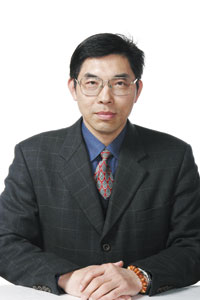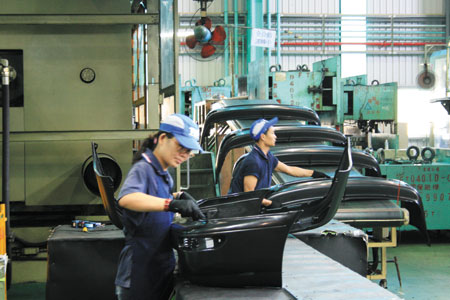TTVMA Section Chief Plots Course for Combating Rising Costs
2008/08/25 | By Quincy LiangA weakening U.S. market, soaring oil prices, and inflationary pressure are bringing change to the global automotive industry, forcing Taiwan's auto-parts industry to explore new strategies to cut costs and stay competitive.
One insider, Huang Wen-fang, offers suggestions on what that course might look like. Chief of the business affairs section under Taiwan Transportation Vehicle Manufacturers' Association (TTVMA), Huang brings extensive experience and data on how to re-gear Taiwan's auto parts industry for the changing competitive landscape in the automotive industry.
Increasing Exports
Taiwan has steadily increased exports of auto parts for many years. In 2007, Huang says, exports in the sector reached NT$147.9 billion (US$4.85 billion at US$1: NT$30.5), up 11.3%.
In the first four months of 2007, Taiwan exported NT$50.9 billion (US$1.67 billion) worth of auto parts, an 8.13% year-on-year, Huang said, with major destination markets including the United States (accounting for 37.52% of the total in 2007), mainland China (6.15%), Germany (3.33%), the UK (2.66%), Canada (2.59%).
Major export items from Taiwan included other vehicle parts (37.2%), passenger-car radial tires (8.28%), auto lamps (head- and tail-lamps, 8.24%), and other body parts and accessories (6.86%).
Rising Fuel and Material Prices
Huang observed that rising fuel and material prices are affecting the automobile and parts markets, and mostly in a negative way.
Since 2006, crude oil prices have risen from US$66 to US$140 a barrel, as of June this year, and some market observers forecast process to rise as high as US$200 in the future. Higher oil prices have also fueled general inflation in production materials and labor costs, while slowing economic growth.
Global warming and carbon reduction issues pose an equally formidable challenge to automakers. As pump prices rise, people are driving less and spurning gas-guzzlers in favor of fuel-sipping compacts and hybrid vehicles.
The fall in new car sales is in fact a mixed blessing for auto-parts makers. For companies specializing in aftermarket (AM) auto-parts, the fall in new car sales could actually prove a boon for business as car owners spend more to maintain and repair existing vehicles. Original equipment (OE) auto-parts makers because, however, are far more vulnerable to the downturn.
The appreciating NT dollar and renminbi (RMB) is also hurting Taiwan auto parts producers and their mainland Chinese subsidiaries, making their products more expensive in overseas markets.
Responses to Inflation & Foreign Exchange Fluctuations
Huang suggests a few guidelines to help local parts suppliers cope with the unfavorable variables facing their industry now.
First, he urges local parts makers to negotiate with customers and jointly map out solutions to rising material prices and currency changes. Second, he suggests that companies adopt measures to reduce risk, such as operating with various foreign currencies.
Huang also proposed that companies reasonably reflect their costs and add value to their products. Further gains could be achieved through better management and cost cutting. Last but not least, Huang says, is that local companies should more aggressively tap new markets and find new customers for high-quality, reasonably-priced parts, rather than bunkering down in the fiercely competitive lower-end segment of the market.

As noted, the current trends offer a few bright rays for AM suppliers. In both North America and Europe local auto-parts makers command about 90% of the collision-parts market (parts often replaced after car collisions such as auto lamps, bumpers, engine hoods, mirrors, radiators, etc.), Huang says. Taiwan is expected to further build on this solid position as few newcomers have the resources to compete with their increasingly strong Taiwanese counterparts.
According to Huang, Taiwanese collision-parts suppliers can fully meet customers' one-stop-shopping needs thanks to their well-established outsourcing channels and central-satellite plant systems. The small-batch, large-variety business mode is the core competitiveness of players in the AM parts market. For sales channels in North America, Huang said, the merger between LKQ Corp., a leading supplier of recycled parts, and Keystone Automotive Industries Inc., the largest supplier of Certified Automotive Parts Association (CAPA) certified AM collision replacement parts to the body shop industry in the US, has further expanded the sales channels of good-quality and certified AM parts in North America, providing a even-wider route for Taiwanese companies in the key market.
In Europe, Huang adds, the new Automotive Block Exemption Regulation (BER) 1400/2002/EC, effective since late 2003, is providing a strong legal base for AM parts in the market. In addition, the European Commission (EC)'s resolution in December 2007 to lift the protection of design patents for automobile exterior parts is expected to greatly facilitate the sales of AM parts in the EU.
Huang also suggests that local companies pay attention to three areas that affect the successful development of foreign auto-parts markets. The first is to further strengthen supply chains, including improving quality stability and putting more resources into product development and patent research.
Second, Huang notes that local auto-parts makers should expand their business scope from AM to original equipment supplied (OES) parts market or to special-vehicle parts. In addition, he suggests that local companies leverage their production flexibility and small-batch, large-variety manufacturing expertise to become first-tier parts suppliers of foreign automakers.
Third, Huang urges research institutes and local AM parts makers to seek more authorizations from international organizations for certifying parts locally. This would shorten the certification period and cut certification costs.

Huang's mantra has been picked up by most major local auto-parts makers in response to rising costs, though each has adopted a different strategy.
Jenny Wu, vice president of Taiwan Kai Yih Industrial Co., Ltd., a leading supplier of AM sheet-metal body parts, points out that although steel prices are rising, the global AM sheet-metal body parts market is too competitive to pass on all of the increases to buyers.
Wu says that her company evaluated each item's competitiveness and cost structure and adopts different strategies for reflecting higher production costs. Some major concerns include the production volume of the item, the progress of tooling amortization, and moves by rivals.
Wu claimed that Taiwan Kai Yih has been automating production to improve quality stability and yield. Currently, the firm runs two fully automated engine-hood lines and one fender production line.
Man Zai Industrial Co., the largest AM automotive condenser maker in Taiwan and the world's first maker of AM small-pitch condensers, is also raising prices depending on product type.
According to Grace Chiang, sales manager of Man Zai, the prices of most OE condenser models is fixed by supply agreements with automakers. For some high volume AM models, she adds, the company has kept the prices unchanged or slightly higher, especially on items sold to the competitive US market.
Chiang claims that Man Zai plans to introduce small-pitch radiators in 2009, giving it a jump on the market that should translate into higher profit margins.




